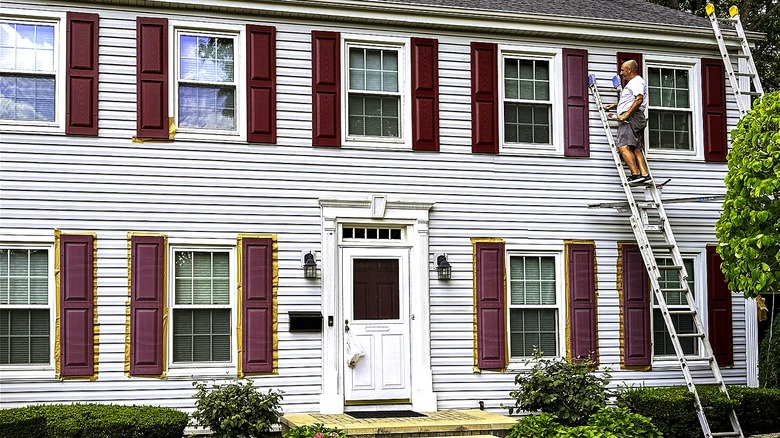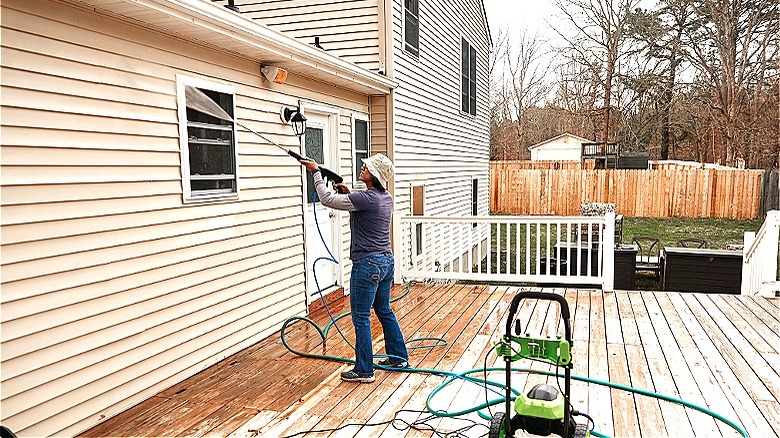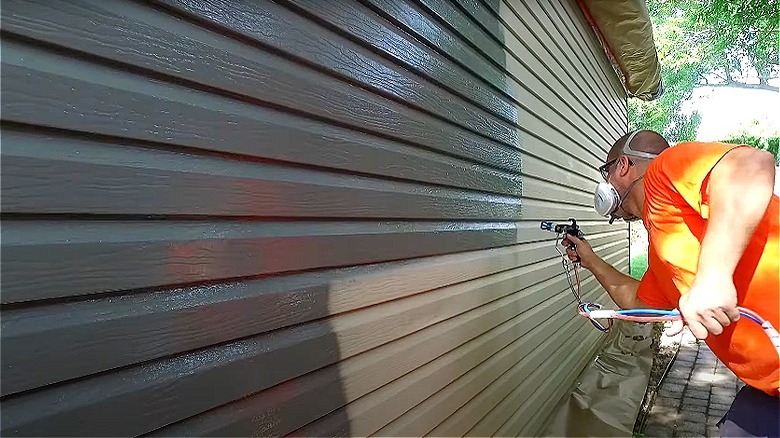Use This Kitchen Essential For A Seamless Paint Job On Aluminum Siding
You probably already know how to use vinegar to keep your house clean. However, don't limit your potential usage scenarios for this substance to inside the house. Vinegar also works well for nontraditional uses, such as preparing aluminum siding for painting. Not only can it clean the siding, but it also can etch the metal slightly, which is key for preparing the metal for a fresh coat.
Among the different types of house siding to consider, aluminum is a popular selection. Aluminum provides resistance to rot, pests, water, and fire, giving it a longevity of close to 40 years that other cheaper siding options may struggle to match. It's paintable, too, ensuring you can enhance its longevity by creating a fresh, updated look. To achieve the best results when painting aluminum siding, it's important to use a high-quality coating and to properly prepare the surface for the application. Vinegar is an inexpensive and effective option for prepping the surface.
Before you begin taking the steps to prepare to paint your aluminum siding, you should inspect it. If it's showing significant damage from dents, crimps, and holes, the paint job is probably not going to deliver the fresh look you're seeking. You may need to simply replace the siding. Further, to keep the aluminum siding looking fresh and renewed, you may need to repeat the painting process every four to six years, always etching it with the vinegar mixture each time before you start to apply the fresh coat.
Using vinegar to etch aluminum siding for painting
Before you can paint your aluminum siding and before you can etch it with vinegar, you should give it a thorough cleaning. Start by removing any algae or mold buildup, using a commercial cleanser that's specifically safe to apply to aluminum siding. It usually will have a bit of bleach in it that can kill the mold. Apply it with a scrub brush and sprayer or power washer on a low or medium setting. Even if you don't have mold and mildew buildup, you can use the cleanser to remove any chalky substances, pollen, or run-of-the-mill dust.
Next, you can rinse the siding. Just use the power washer again on a low setting with only water this time. Rinse all of the siding, starting at the top and working your way down toward the ground. You're now ready to apply a mixture of 1 part white vinegar and 1 part water.
Use a paint roller, a brush, a sponge, or a clean rag to apply it. Let the mixture sit in place for a few minutes before rinsing it away with a power washer or garden hose. Start at the top of the home and work in sections toward the ground, so you can rinse each section after a few minutes. After it dries, you're ready to paint. Use a primer before applying the actual paint color that you want to use on the aluminum siding.
Why vinegar works so well in preparing aluminum siding
Because vinegar is an acidic substance, it works especially well for slightly etching the aluminum siding and preparing it to accept paint. Because aluminum is naturally a smooth surface, it can be difficult to cause the new coat of paint to adhere properly to the metal. The etching process improves the chance of a successful adhesion, helping it to avoid premature peeling, even when exposed to harsh weather and sunlight.
Vinegar is a great choice for this type of work because it's a weak acid, so you don't have a risk of permanently damaging the metal. Additionally, using it for this purpose outdoors is safe for the environment and for most garden plants. Also, because you're rinsing the vinegar off the aluminum siding with water, you'll again be diluting it heavily before it reaches the ground anyway.
If you'd prefer not to use vinegar for this purpose, or if you simply would rather make use of a commercially available product, you have some other options. With a large home, for example, you may need at least a few gallons of vinegar to do the job. If so, you might prefer to just purchase self-etching primer paint, like from SEM Products. Further, if you're going to add a coat of primer before the final coat of paint anyway, you might prefer using self-etching primer to save time versus making a vinegar mixture followed by primer.


